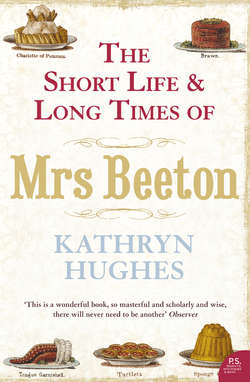Читать книгу The Short Life and Long Times of Mrs Beeton - Kathryn Hughes - Страница 12
INTERLUDE
ОглавлениеWe are so sorry to say that the preserved meats are sometimes carelessly prepared, and, though the statement seems incredible, sometimes adulterated.
ISABELLA BEETON, Book of Household Management
MAKING SURE THAT the food that came to table was pure was something of an obsession with Mrs Beeton. Now that the average household was dependent not on the farmer but the greengrocer and baker for its provisions, the opportunities for contamination were legion. A series of investigations carried out by the Lancet between 1851 and 1854 had revealed to a horrified nation that a whole range of its staple foods were routinely watered down, bulked out, tinted up and, by a whole series of sleights of hand, turned into something that they were not. Every single one of forty-nine random samples of bread examined by the Lancet were found to contain alum; the milk turned out to have water added in amounts ranging from 10 to 50 per cent; and of twenty-nine tins of coffee examined, twenty-eight were adulterated with chicory, mangel-wurzel, and acorn, while a typical sample of tea contained up to half its own weight in iron filings.
The reasons for this terrible state of affairs are various, but mainly come down to the voracious conditions in which retailers were operating in Mrs Beeton’s day. Bread, for instance, was frequently sold below the cost of flour, which meant that the baker had to find some way of bulking out his loaves in order to avoid making a loss. Likewise, milk was bought wholesale for 3d a quart and retailed at 4d. So by adding just 10 per cent of water the tradesman reaped 40 per cent extra profit.
Popularized versions of the Lancet’s findings appeared throughout the press, creating a climate of fearful protest throughout the 1850s. Disappointingly, the resultant 1860 Adulteration of Foods Act turned out to be a toothless tiger, and responsibility for cleaning up Britain’s food was left in the hands of various voluntary groups, as well as to the manufacturers themselves. In 1855 Mr Thomas Blackwell of Crosse and Blackwell explained to a Select Committee that his firm had recently given up the habit of coppering pickles and fruits and artificially colouring sauces, despite consumers initially being disgruntled to discover that pickles were actually brown not green and that anchovies were not naturally a nice bright red. It was not until 1872 that Britain got an effective Adulteration of Food, Drinks and Drugs Act.
During the years when Isabella Beeton first started contributing to Sam’s Englishwoman’s Domestic Magazine anxieties about food adulteration were running high. Readers write in wanting to know how to spot if their bread has been compounded with chalk and are in turn advised on gadgets they can buy to check whether their milk has been watered down. In the Book of Household Management itself the fear initially appears more muted, although hovering over the text you can still discern a continuing worry that the meat that is about to come to table may be off; that vegetables are apt to rot in the containers in which they are stored, thereby becoming ‘impregnated with poisonous particles’; and that the tin that lines saucepans may well be adulterated with lead, ‘a pernicious practice, which in every article connected with the cooking and preparation of food, cannot be too severely reprobated’.
In other words, Mrs Beeton’s imaginary household is in constant danger of being poisoned. What makes it all so frightening is the fact that this is an invisible threat, impossible to detect by the inexpert eye or hand. Here is a neat metaphor for how the middle-class household was beginning to think about itself in the middle of the nineteenth century. The earlier extended household consisting of apprentices, clerks, lodgers, and shopmen (remember the examples of the widowed wholesaler Elizabeth Mayson in Milk Street or the Dolphin with its sisters and cousins and aunts) had now slimmed itself down so that it was more recognizably a nuclear family. This made the boundary between the household and the world beyond the front door clearer, which in turn made the possibility of any breach doubly terrifying. Hence Mrs Beeton’s constant alertness to the danger represented by apparently harmless objects such as saucepans and vegetables that could be smuggled into the family hearth to do their corrupting work.
This is the reason why Beeton gave such a rhapsodic welcome to the introduction of mechanically preserved food. To her tinned meat and fish were not, as they might be to us, a second best option, something for the campsite or the bank holiday. For Mrs Beeton the canning of food represents the privileged opportunity to be in complete control of its purity from farm to fork.
At Leith, in the neighbourhood of Edinburgh, at Aberdeen, at Bordeaux, at Marseilles, and in many parts of Germany, establishments of enormous magnitude exist, in which soup, vegetables, and viands of every description are prepared, in such a manner that they retain their freshness for years.
You get the feeling that if only it were possible, Mrs Beeton would make the household safe by putting it in a tin, soldering the covers and exposing it to boiling water for three hours. That she is forced to acknowledge that adulteration, ‘amazing to say’, can take place even before the tinning process begins, so contaminating the whole food chain, shows that – alas – it is never possible to turn an Englishman’s home into a moated castle, no matter how hard you might try.
